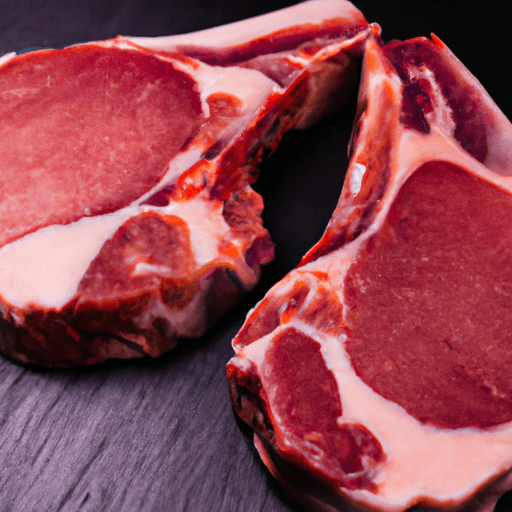The Perfect Pork Steak: Delicious, Nutritious, and Versatile
Pork steak is a mouthwatering and versatile cut of meat that is beloved by both home cooks and professional chefs alike. Its succulent taste, tender texture, and endless culinary possibilities make it a go-to option for many delicious meals. In this blog post, we will explore the world of pork steak, from its delightful flavor profile to its fascinating history. Get ready to tantalize your taste buds and discover the art of cooking with pork steak!
The Taste Experience
Pork steak offers a delectable flavor that is both savory and slightly sweet. Its natural juiciness enhances its tenderness, resulting in a melt-in-your-mouth experience. The balance of fat and meat gives it a rich, buttery undertone that infuses each bite with irresistible flavor. Whether you marinate it, season it with spices, or simply enjoy it with a sprinkle of salt and pepper, pork steak never fails to deliver a delightful culinary experience.
Culinary Uses
One of the great things about pork steak is its versatility in the kitchen. It can be grilled, pan-seared, oven-roasted, or even slow-cooked to perfection. Its thick cut allows for various cooking techniques, making it suitable for a wide range of recipes.
Grilling pork steak is a popular choice, as it creates a beautiful sear, locks in the juices, and adds a smoky dimension to the meat. Pan-searing is also a fantastic option, as it caramelizes the exterior while maintaining a tender and juicy interior. For those who prefer a hands-off approach, slow-cooking pork steak in a flavorful sauce or broth can result in fork-tender meat that practically falls apart.
Pork steak can shine as the centerpiece of a meal or be incorporated into various dishes. Thinly sliced pork steak can be used in stir-fries, tacos, or even sandwiches, adding a burst of flavor and texture. It also pairs wonderfully with a wide variety of sauces, from tangy barbecue to creamy mushroom. Whether you’re a seasoned chef or a kitchen novice, pork steak offers endless possibilities for creativity.
Nutritional Value
Pork steak is not only a treat for your taste buds but also offers several nutritional benefits. It is a great source of high-quality protein, essential for building and repairing tissues in the body. Additionally, pork steak provides a range of vitamins and minerals including vitamin B12, zinc, selenium, and iron. Zinc assists in proper immune function, while iron plays a vital role in oxygen transportation throughout the body.
As with any meat, portion control is key. Including pork steak as part of a balanced diet that includes a variety of fruits, vegetables, and whole grains ensures that you reap its nutritional benefits while maintaining overall health and wellness.
A Fascinating History
Pork has been a staple in diets around the world for centuries, evolving with various culinary traditions. While the exact origin of pork steak is difficult to trace, it has become a beloved dish in many cultures.
In the United States, pork steak gained popularity in the Midwest region, particularly St. Louis, Missouri. It quickly became a local favorite and remains an iconic dish in the area. The unique cut and flavorful taste of St. Louis-style pork steak have garnered a dedicated following.
Fun Facts about Pork Steak
- Pork steak is sometimes referred to as “butcher’s steak” or “blade steak” due to its cut and marbling.
- The way pork steak is cut can vary across regions. In the United States, it is typically cut from the shoulder region, while in some countries, it is cut from the leg or loin.
- Different cultures have their own distinct preparations for pork steak. For instance, Korean cuisine presents pork steak in the form of “samgyeopsal,” which is often enjoyed with various banchan (side dishes).
- The marbling in pork steak contributes to its tenderness and flavor, making it a prized cut among meat lovers.
Time to Get Cooking!
Now that you’re armed with knowledge about the tantalizing taste, culinary uses, nutritional benefits, and a dose of interesting facts about pork steak, it’s time to hit the kitchen and get cooking! Whether you’re firing up the grill, heating up the stovetop, or dusting off the slow cooker, let your creativity soar and enjoy the deliciousness that pork steak brings to your table. Happy cooking!
Note: When preparing and cooking pork steak, it is essential to follow proper food safety guidelines and cooking temperatures to ensure a safe and enjoyable dining experience.
Pork Steak
Origin: Pork steak is believed to have originated in the United States, particularly in the Midwest region. It is commonly associated with traditional American barbecue cuisine.
Common Uses: Pork steaks are often grilled, pan-fried, or broiled to achieve a juicy and flavorful result. They are popularly used as the main ingredient in dishes like BBQ pork steak, pork schnitzel, or simply served with a side of vegetables or salad.
Nutritional Benefits: Pork steaks provide various essential nutrients. They are a good source of high-quality protein, which is important for muscle development and repair. They also contain essential vitamins and minerals such as vitamin B12, zinc, and selenium. However, it is worth noting that the nutritional content can vary depending on the cooking method and the cut of pork used.
Unique Properties: Pork steak is known for its marbling, which refers to the streaks of fat interspersed throughout the meat. This marbling enhances the tenderness and flavor of the steak. The cut of pork used for steak can vary, with popular choices including shoulder steaks, blade steaks, or loin steaks.
Historical Significance: While pork steak has a long history in American barbecue, it was during the mid-20th century that it gained significant popularity. In many Midwestern states, barbecue restaurants became known for their deliciously grilled or smoked pork steaks. Today, it remains a favorite choice in regional barbecues and home cooking across the United States.




Use the share button below if you liked it.
It makes me smile, when I see it.